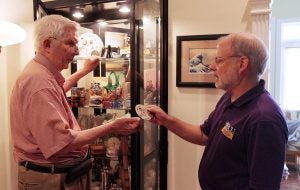ECU dean hears first-hand account of Apollo 11 moon mission

Larry Nichols, right, who worked for Grumman and was involved in the Apollo 11 mission in which man first walked on the moon, shows old lunar module photographs to Dr. Harry Ploehn, dean of the College of Engineering and Technology at East Carolina University, during a visit to Nichols’ home. The 50th anniversary of the Apollo 11 mission is this week. (Photos by Ken Buday)
In a glass display case at the entrance to the Greenville home of Larry and Fran Nichols rests a scale model of the Apollo 11 lunar module that first landed on the moon on July 20, 1969.
“I’d pick it up, but it’s a little fragile,” Nichols said.
Just as the mission was 50 years ago this week.
Nichols worked as an aeronautical engineer for Grumman on the Apollo missions that first put a man on the moon. He recently hosted Dr. Harry Ploehn, dean of the College of Engineering and Technology at East Carolina University, and the two discussed the moon landing and what it took to make that happen.
Nichols watched Apollo 11 take off on July 16, 1969, from the window of a building at Kennedy Space Center in Florida.
“You could feel it take off,” he said.
And as the lunar module made its landing on the moon four days later, he watched data come in from the craft, especially the amount of fuel being used to guide its descent.
“There was a dead zone at 400 feet (above the moon’s surface) where they could not have gotten off if something went wrong,” Nichols said. “They almost ran out of fuel. They were very close.”
Nichols said it wasn’t enough just to land on the moon. The astronauts had to return.

Larry Nichols shows an Apollo 11 Medallion .
“The first thing they did on the lunar surface was get ready to leave,” Nichols said, adding they had to be prepared to leave quickly if any emergency had arisen.
But instead, Neil Armstrong descended the ladder and took that “one giant leap for mankind,” setting foot on the moon.
“The entire population of the world was watching,” Nichols said.
Ploehn was one of those.
“I was 8 years old,” Ploehn said. “My parents got me out of bed, and we watched it on TV. It was a huge milestone in civilization.”
Nichols, who is now 84 years old, said much of his work at Grumman involved testing of the lunar module. He said that included an abort system that he was grateful never had to be used.
Asked if he ever wanted to go to the moon, Nichols declined. “That takes a lot of guts,” he said.
Despite being one of thousands of people who helped put men on the moon, he said his proudest moment working with the space program didn’t involve a moon landing at all.
“Apollo 13,” he said, citing the mission in which an explosion in space put the lives of three astronauts in jeopardy. People on the ground worked to return the astronauts safely home, including burning the engines of the lunar module in open space, something they were not designed to do.

Larry Nichols, left, shows Apollo 11 items to Dr. Harry Ploehn, dean of the College of Engineering and Technology at East Carolina University.
“That was us,” Nichols said of the Grumman workers. “They (the astronauts) couldn’t turn on the computer because they didn’t have the power, but that was our system.”
Photographs of various crafts and space launches dot the walls of the Nichols home. He has home movies of the various Apollo launches that his wife, Fran, captured. One framed artifact includes patches of all the Apollo missions on which he worked, as well as the Hubble telescope on which Nichols also worked.
Asked about what today’s generation could do to get in the aerospace industry, Nichols had a simple answer.
“Take all the math and science classes you can,” he said.
Nichols said he has no special plans to mark the 50th anniversary of when man first walked on the moon. He expressed disappointment that three scheduled Apollo missions to the moon were canceled, and that the last time man set foot on the moon was in 1972, 47 years ago.
“We did it right, but we haven’t been back since,” Nichols said.
– By Ken Buday, University Communications